วัดพระเชตุพนวิมลมังคลาราม หรือ วัดโพธิ์ ถนนสนามไชย แขวงพระบรมมหาราชวัง เขตพระนคร กรุงเทพมหานคร.
Wat Pho, Bangkok, Thailand.
Photo Gallery. Asian Historical Architecture.
ขอบคุณ ภาพและข้อมูล จาก http://www.orientalarchitecture.com/sid/611/thailand/bangkok/wat-pho
Wat Pho (วัดโพธิ์) (1793 onward)
Wat Pho is a large Buddhist temple south of the royal palace. Although its history extends back at least to the 16th century, the current structures all date from 1793 or later. When the future King Rama I, the founder of the Chakri dynasty, unseated his rival Tak Sin in a bloody war, he transferred the capital across the river from Tonburi to what is today downtown Bangkok. As part of his grand development scheme, he renovated a dilapidated monastery called Wat Potaram. He renamed it Wat Pho Chetuphon, or the Bo-Tree monastery, and funded a construction effort that lasted seven years. The centerpiece of the temple was an enormous statue of the reclining Buddha, over 46 meters long and 15 meters high. Covered in gold leaf, it is housed in a special building built for its protection.
Rama III, the third king of the Chakri dynasty, enlarged the temple over a 17-year period beginning in 1839. He envisioned the temple as not just a monastery, but as a university that would house all forms of knowledge. He endowed the university with gifts and funding, creating Thailand's first public education center. He also spent lavishly to upgrade the gilding, icons, and decorations on the temple grounds.
Wat Pho is divided by a narrow road. Only the north half (shown above) is of interest to tourists.
Location
The approximate location of the site is 13.746559' N, 100.493370' E (WGS 84 map datum).
วัดพระเชตุพนวิมลมังคลาราม หรือ วัดโพธิ์ ถนนสนามไชย แขวงพระบรมมหาราชวัง เขตพระนคร กรุงเทพมหานคร.
02.Wat Pho, Bangkok, Thailand. Photo Gallery. Asian Historical Architecture.
วัดพระเชตุพนวิมลมังคลาราม หรือ วัดโพธิ์ ถนนสนามไชย แขวงพระบรมมหาราชวัง เขตพระนคร กรุงเทพมหานคร.
03.Wat Pho, Bangkok, Thailand. Photo Gallery. Asian Historical Architecture.
วัดพระเชตุพนวิมลมังคลาราม หรือ วัดโพธิ์ ถนนสนามไชย แขวงพระบรมมหาราชวัง เขตพระนคร กรุงเทพมหานคร.
04.Wat Pho, Bangkok, Thailand. Photo Gallery. Asian Historical Architecture.
วัดพระเชตุพนวิมลมังคลาราม หรือ วัดโพธิ์ ถนนสนามไชย แขวงพระบรมมหาราชวัง เขตพระนคร กรุงเทพมหานคร.
05.Wat Pho, Bangkok, Thailand. Photo Gallery. Asian Historical Architecture.
วัดพระเชตุพนวิมลมังคลาราม หรือ วัดโพธิ์ ถนนสนามไชย แขวงพระบรมมหาราชวัง เขตพระนคร กรุงเทพมหานคร.
06.Wat Pho, Bangkok, Thailand. Photo Gallery. Asian Historical Architecture.
วัดพระเชตุพนวิมลมังคลาราม หรือ วัดโพธิ์ ถนนสนามไชย แขวงพระบรมมหาราชวัง เขตพระนคร กรุงเทพมหานคร.
07.Wat Pho, Bangkok, Thailand. Photo Gallery. Asian Historical Architecture.
วัดพระเชตุพนวิมลมังคลาราม หรือ วัดโพธิ์ ถนนสนามไชย แขวงพระบรมมหาราชวัง เขตพระนคร กรุงเทพมหานคร.
08.Wat Pho, Bangkok, Thailand. Photo Gallery. Asian Historical Architecture.
วัดพระเชตุพนวิมลมังคลาราม หรือ วัดโพธิ์ ถนนสนามไชย แขวงพระบรมมหาราชวัง เขตพระนคร กรุงเทพมหานคร.
09.Wat Pho, Bangkok, Thailand. Photo Gallery. Asian Historical Architecture.
วัดพระเชตุพนวิมลมังคลาราม หรือ วัดโพธิ์ ถนนสนามไชย แขวงพระบรมมหาราชวัง เขตพระนคร กรุงเทพมหานคร.
10.Wat Pho, Bangkok, Thailand. Photo Gallery. Asian Historical Architecture.
วัดพระเชตุพนวิมลมังคลาราม หรือ วัดโพธิ์ ถนนสนามไชย แขวงพระบรมมหาราชวัง เขตพระนคร กรุงเทพมหานคร.
11.Wat Pho, Bangkok, Thailand. Photo Gallery. Asian Historical Architecture.
วัดพระเชตุพนวิมลมังคลาราม หรือ วัดโพธิ์ ถนนสนามไชย แขวงพระบรมมหาราชวัง เขตพระนคร กรุงเทพมหานคร.
12.Wat Pho, Bangkok, Thailand. Photo Gallery. Asian Historical Architecture.
วัดพระเชตุพนวิมลมังคลาราม หรือ วัดโพธิ์ ถนนสนามไชย แขวงพระบรมมหาราชวัง เขตพระนคร กรุงเทพมหานคร.
13.Wat Pho, Bangkok, Thailand. Photo Gallery. Asian Historical Architecture.
วัดพระเชตุพนวิมลมังคลาราม หรือ วัดโพธิ์ ถนนสนามไชย แขวงพระบรมมหาราชวัง เขตพระนคร กรุงเทพมหานคร.
14.Wat Pho, Bangkok, Thailand. Photo Gallery. Asian Historical Architecture.
วัดพระเชตุพนวิมลมังคลาราม หรือ วัดโพธิ์ ถนนสนามไชย แขวงพระบรมมหาราชวัง เขตพระนคร กรุงเทพมหานคร.
15.Wat Pho, Bangkok, Thailand. Photo Gallery. Asian Historical Architecture.
วัดพระเชตุพนวิมลมังคลาราม หรือ วัดโพธิ์ ถนนสนามไชย แขวงพระบรมมหาราชวัง เขตพระนคร กรุงเทพมหานคร.
16.Wat Pho, Bangkok, Thailand. Photo Gallery. Asian Historical Architecture.
วัดพระเชตุพนวิมลมังคลาราม หรือ วัดโพธิ์ ถนนสนามไชย แขวงพระบรมมหาราชวัง เขตพระนคร กรุงเทพมหานคร.
17.Wat Pho, Bangkok, Thailand. Photo Gallery. Asian Historical Architecture.
วัดพระเชตุพนวิมลมังคลาราม หรือ วัดโพธิ์ ถนนสนามไชย แขวงพระบรมมหาราชวัง เขตพระนคร กรุงเทพมหานคร.
18.Wat Pho, Bangkok, Thailand. Photo Gallery. Asian Historical Architecture.
วัดพระเชตุพนวิมลมังคลาราม หรือ วัดโพธิ์ ถนนสนามไชย แขวงพระบรมมหาราชวัง เขตพระนคร กรุงเทพมหานคร.
19.Wat Pho, Bangkok, Thailand. Photo Gallery. Asian Historical Architecture.
วัดพระเชตุพนวิมลมังคลาราม หรือ วัดโพธิ์ ถนนสนามไชย แขวงพระบรมมหาราชวัง เขตพระนคร กรุงเทพมหานคร.
20.Wat Pho, Bangkok, Thailand. Photo Gallery. Asian Historical Architecture.
วัดพระเชตุพนวิมลมังคลาราม หรือ วัดโพธิ์ ถนนสนามไชย แขวงพระบรมมหาราชวัง เขตพระนคร กรุงเทพมหานคร.
21.Wat Pho, Bangkok, Thailand. Photo Gallery. Asian Historical Architecture.
วัดพระเชตุพนวิมลมังคลาราม หรือ วัดโพธิ์ ถนนสนามไชย แขวงพระบรมมหาราชวัง เขตพระนคร กรุงเทพมหานคร.
22.Wat Pho, Bangkok, Thailand. Photo Gallery. Asian Historical Architecture.
วัดพระเชตุพนวิมลมังคลาราม หรือ วัดโพธิ์ ถนนสนามไชย แขวงพระบรมมหาราชวัง เขตพระนคร กรุงเทพมหานคร.
23.Wat Pho, Bangkok, Thailand. Photo Gallery. Asian Historical Architecture.
วัดพระเชตุพนวิมลมังคลาราม หรือ วัดโพธิ์ ถนนสนามไชย แขวงพระบรมมหาราชวัง เขตพระนคร กรุงเทพมหานคร.
24.Wat Pho, Bangkok, Thailand. Photo Gallery. Asian Historical Architecture.
วัดพระเชตุพนวิมลมังคลาราม หรือ วัดโพธิ์ ถนนสนามไชย แขวงพระบรมมหาราชวัง เขตพระนคร กรุงเทพมหานคร.
25.Wat Pho, Bangkok, Thailand. Photo Gallery. Asian Historical Architecture.
วัดพระเชตุพนวิมลมังคลาราม หรือ วัดโพธิ์ ถนนสนามไชย แขวงพระบรมมหาราชวัง เขตพระนคร กรุงเทพมหานคร.
26.Wat Pho, Bangkok, Thailand. Photo Gallery. Asian Historical Architecture.
วัดพระเชตุพนวิมลมังคลาราม หรือ วัดโพธิ์ ถนนสนามไชย แขวงพระบรมมหาราชวัง เขตพระนคร กรุงเทพมหานคร.
27.Wat Pho, Bangkok, Thailand. Photo Gallery. Asian Historical Architecture.
วัดพระเชตุพนวิมลมังคลาราม หรือ วัดโพธิ์ ถนนสนามไชย แขวงพระบรมมหาราชวัง เขตพระนคร กรุงเทพมหานคร.
28.Wat Pho, Bangkok, Thailand. Photo Gallery. Asian Historical Architecture.
วัดพระเชตุพนวิมลมังคลาราม หรือ วัดโพธิ์ ถนนสนามไชย แขวงพระบรมมหาราชวัง เขตพระนคร กรุงเทพมหานคร.
29.Wat Pho, Bangkok, Thailand. Photo Gallery. Asian Historical Architecture.
วัดพระเชตุพนวิมลมังคลาราม หรือ วัดโพธิ์ ถนนสนามไชย แขวงพระบรมมหาราชวัง เขตพระนคร กรุงเทพมหานคร.
30.Wat Pho, Bangkok, Thailand. Photo Gallery. Asian Historical Architecture.
วัดพระเชตุพนวิมลมังคลาราม หรือ วัดโพธิ์ ถนนสนามไชย แขวงพระบรมมหาราชวัง เขตพระนคร กรุงเทพมหานคร.
31.Wat Pho, Bangkok, Thailand. Photo Gallery. Asian Historical Architecture.
วัดพระเชตุพนวิมลมังคลาราม หรือ วัดโพธิ์ ถนนสนามไชย แขวงพระบรมมหาราชวัง เขตพระนคร กรุงเทพมหานคร.
32.Wat Pho, Bangkok, Thailand. Photo Gallery. Asian Historical Architecture.
วัดพระเชตุพนวิมลมังคลาราม หรือ วัดโพธิ์ ถนนสนามไชย แขวงพระบรมมหาราชวัง เขตพระนคร กรุงเทพมหานคร.
33.Wat Pho, Bangkok, Thailand. Photo Gallery. Asian Historical Architecture.
วัดพระเชตุพนวิมลมังคลาราม หรือ วัดโพธิ์ ถนนสนามไชย แขวงพระบรมมหาราชวัง เขตพระนคร กรุงเทพมหานคร.
34.Wat Pho, Bangkok, Thailand. Photo Gallery. Asian Historical Architecture.
วัดพระเชตุพนวิมลมังคลาราม หรือ วัดโพธิ์ ถนนสนามไชย แขวงพระบรมมหาราชวัง เขตพระนคร กรุงเทพมหานคร.
35.Wat Pho, Bangkok, Thailand. Photo Gallery. Asian Historical Architecture.
วัดพระเชตุพนวิมลมังคลาราม หรือ วัดโพธิ์ ถนนสนามไชย แขวงพระบรมมหาราชวัง เขตพระนคร กรุงเทพมหานคร.
36.Wat Pho, Bangkok, Thailand. Photo Gallery. Asian Historical Architecture.
วัดพระเชตุพนวิมลมังคลาราม หรือ วัดโพธิ์ ถนนสนามไชย แขวงพระบรมมหาราชวัง เขตพระนคร กรุงเทพมหานคร.
37.Wat Pho, Bangkok, Thailand. Photo Gallery. Asian Historical Architecture.
วัดพระเชตุพนวิมลมังคลาราม หรือ วัดโพธิ์ ถนนสนามไชย แขวงพระบรมมหาราชวัง เขตพระนคร กรุงเทพมหานคร.
38.Wat Pho, Bangkok, Thailand. Photo Gallery. Asian Historical Architecture.
วัดพระเชตุพนวิมลมังคลาราม หรือ วัดโพธิ์ ถนนสนามไชย แขวงพระบรมมหาราชวัง เขตพระนคร กรุงเทพมหานคร.
39.Wat Pho, Bangkok, Thailand. Photo Gallery. Asian Historical Architecture.
วัดพระเชตุพนวิมลมังคลาราม หรือ วัดโพธิ์ ถนนสนามไชย แขวงพระบรมมหาราชวัง เขตพระนคร กรุงเทพมหานคร.
40.Wat Pho, Bangkok, Thailand. Photo Gallery. Asian Historical Architecture.
วัดพระเชตุพนวิมลมังคลาราม หรือ วัดโพธิ์ ถนนสนามไชย แขวงพระบรมมหาราชวัง เขตพระนคร กรุงเทพมหานคร.
41.Wat Pho, Bangkok, Thailand. Photo Gallery. Asian Historical Architecture.
วัดพระเชตุพนวิมลมังคลาราม หรือ วัดโพธิ์ ถนนสนามไชย แขวงพระบรมมหาราชวัง เขตพระนคร กรุงเทพมหานคร.
42.Wat Pho, Bangkok, Thailand. Photo Gallery. Asian Historical Architecture.
วัดพระเชตุพนวิมลมังคลาราม หรือ วัดโพธิ์ ถนนสนามไชย แขวงพระบรมมหาราชวัง เขตพระนคร กรุงเทพมหานคร.
43.Wat Pho, Bangkok, Thailand. Photo Gallery. Asian Historical Architecture.
วัดพระเชตุพนวิมลมังคลาราม หรือ วัดโพธิ์ ถนนสนามไชย แขวงพระบรมมหาราชวัง เขตพระนคร กรุงเทพมหานคร.Wat Pho, Bangkok, Thailand.
Photo Gallery. Asian Historical Architecture.
ขอบคุณ ภาพและข้อมูล จาก http://www.orientalarchitecture.com/sid/611/thailand/bangkok/wat-pho
ขอบคุณ ข้อมูลและภาพ จาก https://en.wikipedia.org/wiki/Wat_Pho
Wat Pho
From Wikipedia, the free encyclopedia
| Wat Pho | |
|---|---|
| วัดโพธิ์ | |
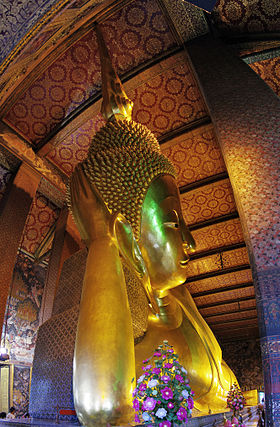
View of the Reclining Buddha
| |
| Basic information | |
| Geographic coordinates | 13°44′47″N100°29′37″ECoordinates: 13°44′47″N 100°29′37″E |
| Affiliation | Theravada Buddhism |
| Country | Thailand |
| Website | www.watpho.com |
| Architectural description | |
| Founder | Unknown King Rama I (re-establishment) |
| Completed | 16th century 1788 CE (re-establishment)[1] |
Wat Pho (Thai: วัดโพธิ์, IPA: [wát pʰoː]), also spelt Wat Po, is a Buddhist temple complex in the Phra Nakhon District, Bangkok, Thailand. It is on Rattanakosin Island, directly south of the Grand Palace.[2] Known also as the Temple of the Reclining Buddha, its official name is Wat Phra Chetuphon Vimolmangklararm Rajwaramahaviharn[1] (Thai: วัดพระเชตุพนวิมลมังคลารามราชวรมหาวิหาร; rtgs: Wat Phra Chettuphon Wimonmangkhlaram Ratchaworamahawihan; IPA: [wát pʰráʔ tɕʰê:t.tù.pʰon wíʔ.mon.maŋ.kʰlaː.raːm râːt.tɕʰá.wɔː.ráʔ.má.hǎː.wíʔ.hǎːn]).[3] The more commonly known name, Wat Pho, is a contraction of its older name Wat Photaram (Thai: วัดโพธาราม; rtgs: Wat Photharam).[4]
The temple is first on the list of six temples in Thailand classed as the highest grade of the first-class royal temples.[5][6] It is associated with King Rama I who rebuilt the temple complex on an earlier temple site, and became his main temple where some of his ashes are enshrined.[7] The temple was later expanded and extensively renovated by Rama III. The temple complex houses the largest collection of Buddha images in Thailand, including a 46 m long reclining Buddha. The temple is considered the earliest centre for public education in Thailand, and the marble illustrations and inscriptions placed in the temple for public instructions has been recognised by UNESCO in its Memory of the World Programme. It houses a school of Thai medicine, and is also known as the birthplace of traditional Thai massage which is still taught and practiced at the temple.[8]
Contents
[hide]History[edit]
Wat Pho is one of Bangkok's oldest temples. It existed before Bangkok was established as the capital by King Rama I. It was originally named Wat Photaram or Podharam, from which the name Wat Pho is derived.[4][9] The name refers the monastery of the Bodhi tree in Bodh Gaya, India where Buddha is believed to have attained enlightenment.[6][10] The older temple is thought to have been built or expanded some time during the reign of King Phetracha (1688–1703) of the Ayuthaya period on an even earlier temple site, its founder unknown.[6][11] After the fall of Ayutthaya to the Burmese, King Taksin moved the capital to Thonburi where he located his palace beside Wat Arun on the opposite side of the river from Wat Pho, and the proximity of Wat Pho to this royal palace elevated it to the status of a wat luang (royal monastery).[6]
In 1782, King Rama I moved the capital from Thonburi across the river to Bangkok and built the Grand Palace adjacent to Wat Pho. In 1788, he ordered the construction and renovation at the old temple site of Wat Pho, which had by then become dilapidated.[1] The site, which was marshy and uneven, was drained and filled in before construction began. During its construction Rama I also initiated a project to remove Buddha images from abandoned temples in Ayutthaya, Sukhothai, as well other sites in Thailand, and many of these Buddha images were kept at Wat Pho.[12] These include the remnants of an enormous Buddha image from Ayuthaya's Wat Phra Si Sanphet destroyed by the Burmese in 1767, and these were incorporated into a chedi in the complex.[13] The rebuilding took over seven years to complete. In 1801, twelve years after work began, the new temple complex was renamed Phra Chetuphon Vimolmangklavas in reference to the vihara of Jetavana, and it became the main temple for Rama I.[14][15]
The complex underwent significant changes in the next 260 years, particularly during the reign of Rama III (1824-1851 CE). In 1832, King Rama III began renovating and enlarging the temple complex, a process that took 16 years and seven months to complete. The ground of the temple complex was expanded to 22 acres, and most of the structures now present in Wat Pho were either built or rebuilt in this period, including the chapel of the reclining Buddha. He also turned the temple complex into a public center of learning by decorating the walls of the buildings with diagrams and inscriptions on various subjects.[9]:90 ] On 21 February 2008, these marble illustrations and inscriptions was registered in the Memory of the World Programme launched by UNESCO to promote, preserve and propagate the wisdom of the world heritage.[16][17] Wat Pho is regarded as Thailand’s first university and a center for traditional Thai massage. It served as a medical teaching center in the mid-19th century before the advent of modern medicine, and the temple remains a center for traditional medicine today where a private school for Thai medicine founded in 1957 still operates.[18][19]
The name of the complex was changed again to Wat Phra Chetuphon Vimolmangklararm during the reign of King Rama IV.[1] Apart from the construction of a fourth great chedi and minor modifications by Rama IV, there had been no significant changes to Wat Pho since. Repair work, however, is a continuing process, often funded by devotees of the temple. The temple was restored again in 1982 before the Bangkok Bicentennial Celebration.[20]
The Temple complex[edit]
Wat Pho is one of the largest and oldest wats in Bangkok with an area of 50 rai, 80,000 square metres,[21] and is home to more than one thousand Buddha images, as well as one of the largest single Buddha images at 150 feet (46 m) in length.[22] The Wat Pho complex consists of two walled compounds bisected by Chetuphon Road running in the east–west direction. The larger northern walled compound, the phutthawat, is the part open to visitors and contains the finest buildings dedicated to the Buddha, including the bot with its four directional viharn, and the temple housing the reclining Buddha.[14] The southern compound, the sankhawat, contains the residential quarters of the monks and a school. The perimeter wall of the main temple complex has sixteen gates, two of which serve as entrances for the public (one on Chetuphon Road, the other near the northwest corner).[10]
The temple grounds contain 91 small chedis (stupas or mounds), four great chedis, two belfries, a bot (central shrine), a number of viharas (halls) and other buildings such as pavilions, as well as gardens and a small temple museum. Architecturally the chedis and buildings in the complex are different in style and sizes.[18] A number of large Chinese statues, some of which depict Europeans, are also found within the complex guarding the gates of the perimeter walls as well as other gates within the compound. These stone statues were originally imported as ballast on ships trading with China.[18]
Wat Pho was intended to serve as a place of education for the general public. To this end a pictorial encyclopedia was engraved on granite slabs covering eight subject areas, namely history, medicine, health, custom, literature, proverbs, lexicography, and the Buddhist religion.[19][23] These plaques, inscribed with texts and illustration on medicine, Thai traditional massage, and other subjects, are placed around the temple,[24] for example, within the Sala Rai or satellite open pavilions. Dotted around the complex are 24 small rock gardens (Khao Mor) illustrating rock formations of Thailand, and one, called the Contorting Hermit Hill, contains some statues showing methods of massage and yoga positions.[18][23] There are also drawings of constellations on the wall of the library, inscriptions on local administration, as well as paintings of folk tales and animal husbandry.[19]
Phra Ubosot[edit]
Phra Ubosot (Phra Uposatha) or bot is the ordination hall, the main hall used for performing Buddhist rituals, and the most sacred building of the complex. It was constructed by King Rama I in the Ayuthaya style, and later enlarged and reconstructed in the Rattanakosin style by Rama III. The bot was dedicated in 1791, before the rebuilding of Wat Pho was completed.[25] This building is raised on a marble platform, and the ubosot lies in the center of courtyard enclosed by a double cloister (Phra Rabiang).
Inside the ubosot is a gold and crystal three-tiered pedestal topped with a gilded Buddha made of a gold-copper alloy, and over the statue is a nine-tiered umbrella representing the authority of Thailand.[18] The Buddha image, known as Phra Buddha Theva Patimakorn and thought to be from the Ayutthaya period, was moved here by Rama I from Wat Sala Si Na (now called Wat Khuhasawa) in Thonburi.[26] Rama IV later placed some ashes of Rama I under the pedestal of the Buddha image so that the public may pay homage to both Rama I and the Buddha at the same time. There are also ten images of Buddha's disciples in the hall, Moggalana on its left and Sariputta on its right, and a further eight Arahants below.[1][27]
The exterior balustrade surrounding the main hall has around 150 depictions in stone of the epic, Ramakien, the ultimate message of which is transcendence from secular to spiritual dimensions.[10] The stone panels were recovered from a temple in Ayuthaya. The ubosot is enclosed by a low wall called kamphaeng kaew,[28] which is punctuated by gateways guarded by mythological lions, as well as eight structures that house the bai sema stone markers that delineate the sacred space of the bot.
- Phra Rabiang - This double cloister contains around 400 images of Buddha from northern Thailand selected out of the 1,200 originally brought by King Rama I.[10] Of these Buddha images, 150 are located on the inner side of the double cloister, another 244 images are on the outer side.[27] These Buddha figures, some standing and some seated, are evenly mounted on matching gilded pedestals. These images are from different periods, such as Chiangsaen, Sukhothai, U-Thong, and Ayutthaya, but were renovated by Rama I and covered with stucco and gold leaves to make them look similar.[27]
The Phra Rabiang is intersected by four viharns. The viharn in the east contains an 8 metre tall standing Buddha, the Buddha Lokanatha, originally from Ayutthaya. In its antechamber is Buddha Maravichai, sitting under a bodhi tree, originally from Sawankhalok of the late Sukhothai period. The one on the west has a seated Buddha sheltered by a naga, the Buddha Chinnasri, while the Buddha on the south, the Buddha Chinnaraja, has five disciples seated in front listening to his first sermon. Both Buddhas were brought from Sukhothai by Rama I. The Buddha in the north viharn called Buddha Palilai was cast in the reign of Rama I.[27] The viharn on the west also contains a small museum.[29]
- Phra Prang - There are four towers, or phra prang, at each corner of the courtyard around the bot. Each of the towers is tiled with marbles and contains four Khmer-style statues which are the guardian divinities of the Four Cardinal Points.[30]
Phra Maha Chedi Si Rajakarn[edit]
This is a group of four large stupas, each 42 metres high. These four chedis are dedicated to the first four Chakri kings.[8] The first, in green mosaic tiles, was constructed by Rama I to house the remnants of the great Buddha from Ayuthaya, which was scorched to remove its gold covering by the Burmese. Two more were built by Rama III, one in white tiles to hold the ashes of his father Rama II, another in yellow for himself. A fourth in blue was built by Rama IV who then enclosed the four chedis leaving no space for more to be built.[31]
Viharn Phranorn[edit]
The viharn or wihan contains the reclining Buddha and was constructed in the reign of Rama III emulating the Ayutthaya-style. The interior is decorated with panels of mural.[32]
Adjacent to this building is a small raised garden (Missakawan Park) with a Chinese-style pavilion; the centrepiece of the garden is a bodhi tree which was propagated from the Jaya Sri Maha Bodhi tree in Sri Lanka that is believed to have originally came from a tree in India where Buddha sat while awaiting enlightenment.[33]
Phra Mondop[edit]
Phra Mondop or the ho trai is the Scripture Hall containing a small library of Buddhist scriptures. The building is not generally open to the public as the scriptures, which are inscribed on palm leaves, need to be kept in a controlled environment for preservation.[34] The library was built by King Rama III. Guarding its entrance are figures called Yak Wat Pho (Wat Pho’s Giants) placed in niches beside the gates.[35] Around Phra Mondop are three pavilions with mural paintings of the beginning of Ramayana.
Other structures[edit]
- Phra Chedi Rai - Outside the Phra Rabiang cloisters are dotted many smaller chedis, called Phra Chedi Rai. Seventy-one of these small chedis were built by Rama III, each five metres in height. There are also four groups of five chedis that shared a single base built by Rama I, one on each corner outside the cloister.[36] The 71 chedis of smaller size contain the ashes of the royal family, and 20 slightly larger ones clustered in groups of five contain the relics of Buddha.[18]
- Sala Karn Parien - This hall is next to the Phra Mondop at the southwest corner of the compound, and is thought to date from the Ayutthaya period. It serves as a learning and meditation hall.[37] The building contains the original Buddha image from the bot which was moved to make way for the Buddha image currently in the bot.[25]Next to it is a garden called The Crocodile Pond.
- Sala Rai - There are 16 satellite pavilions, most of them placed around the edge of the compound, and murals depicting the life of Buddha may be found in some of these. Two of these are the medical pavilions between Phra Maha Chedi Si Ratchakarn and the main chapel. The north medicine pavilion contains Thai traditional massage inscriptions with 32 drawings of massage positions on the walls while the one to the south has a collection of inscriptions on guardian angel that protects the newborn.[38]
- Phra Viharn Kod - This is the gallery which consists of four viharas, one on each corner outside the Phra Rabiang.[39][40]
- Tamnak Wasukri - Also called the poet's house, this is the former residence of Prince Patriarch Paramanujita Jinorasa, a Thai poet.[41] This building is in the living quarters of the monks in the southern compound and is open once a year on his birthday.
Reclining Buddha[edit]
The chapel and the reclining Buddha (Phra Buddhasaiyas, Thai: พระพุทธไสยาสน์) were built by Rama III in 1832.[42] The image of the reclining Buddha represents the entry of Buddha into Nirvana and the end of all reincarnations.[2] The posture of the image is referred to as sihasaiyas, the posture of a sleeping or reclining lion. The figure is 15 m high and 46 m long, and it is one of the largest Buddha statues in Thailand.[1] The right arm of the Buddha supports the head with tight curls, which rests on two box-pillows richly encrusted with glass mosaics.[10] The figure has a brick core, which was modelled and shaped with plaster, then gilded.[43]
The soles of the feet of the Buddha are 3 m high and 4.5 m long, and inlaid with mother-of-pearl. They are each divided into 108 arranged panels, displaying the auspicious symbols by which Buddha can be identified, such as flowers, dancers, white elephants, tigers, and altar accessories.[10] At the center of each foot is a circle representing a chakra or energy point. There are 108 bronze bowls in the corridor representing the 108 auspicious characters of Buddha. Visitors may drop coins in these bowls as it is believed to bring good fortune, and it also helps the monks to maintain the wat.[8]
Although the reclining Buddha is not a pilgrimage centre, it remains an object of popular piety.[18] An annual celebration for the reclining Buddha is held around the time of the Siamese Songkran or New Year in April, which also helps raise funds for the upkeep of Wat Pho.[44]
Thai massage[edit]
The temple is considered the first public university of Thailand, teaching students in the fields of religion, science, and literature through murals and sculptures.[8] A school for traditional medicine and massage was established at the temple in 1955, and now offers four courses in Thai medicine: Thai pharmacy, Thai medical practice, Thai midwifery, and Thai massage.[45] This, the Wat Pho Thai Traditional Medical and Massage School, is the first school of Thai medicine approved by the Thai Ministry of Education, and one of the earliest massage schools. It remains the national headquarters and the center of education of traditional Thai medicine and massage to this day. Courses on Thai massage are held in Wat Pho, and these may last a few weeks to a year.[18] Two pavilions at the eastern edge of the Wat Pho compound are used as classrooms for practising Thai traditional massage and herbal massage, and visitors can received massage treatment here for a fee.[46][47] Foreigners from 135 countries have studied Thai massage at Wat Po.[48]
There are many medical inscriptions and illustrations placed in various buildings around the temple complex, some of which serve as instructions for Thai massage therapists, particularly those in the north medical pavilion.[49] Among these are 60 inscribed plaques, 30 each for the front and back of human body, showing pressure points used in traditional Thai massage. These therapeutic points and energy pathways, known as sen, are engraved on the human figures, with explanations given on the walls next to the plaques.[50] They are based on the principle of energy flow similar to that of Chinese acupuncture. The understanding so far is that the figures represent relationships between anatomical locations and effects produced by massage treatment at those locations, but full research on the diagrams has yet to be completed.[51]
Site plan[edit]
|
16. Viharn Phranorn
(Chapel of the Reclining Buddha) 17. Sala Karn Parien 18. Missakawan Park 19. The Crocodile Pond 20. Belfry 21. Gates 22. Massage service 23. Sala Rai |
ขอบคุณ ข้อมูลและภาพ จาก https://th.wikipedia.org/wiki/วัดพระเชตุพนวิมลมังคลาราม หรือ วัดโพธิ์
วัดพระเชตุพนวิมลมังคลารามราชวรมหาวิหาร
จากวิกิพีเดีย สารานุกรมเสรี
| วัดพระเชตุพนวิมลมังคลาราม ราชวรมหาวิหาร | |
|---|---|

ตุ๊กตาจีน ประติมากรรมประจำวัดพระเชตุพน
| |
| ข้อมูลทั่วไป | |
| ชื่อ | วัดโพธิ์ ท่าเตียน |
| ที่ตั้ง | 2 ถนนสนามไชย แขวงพระบรมมหาราชวัง เขตพระนคร กรุงเทพมหานคร |
| ประเภท | พระอารามหลวงชั้นเอก ชนิดราชวรมหาวิหาร |
| นิกาย | เถรวาท มหานิกาย |
| พระประธาน | พระพุทธเทวปฏิมากร |
| พระพุทธรูปสำคัญ | พระพุทธไสยาส พระพุทธโลกนาถ พระพุทธศาสดามหากรุณาธิคุณ พระพุทธมารวิชัยอภัยปรปักษ์ พระพุทธชินราชวโรวาท พระพุทธชินสีห์มุนีนาถ พระพุทธปาลิไลยภิรัติไตรวิเวก พระศรีสรรเพชญุดาญาณ |
| วัดประจำรัชกาลที่ 1 | |
| จุดสนใจ | วิหารพระพุทธไสยาสน์ วิหารทิศฝั่งตะวันออก (วิหารพระโลกนาถ) และพระอุโบสถ |
| กิจกรรม | นวดแผนไทย |
| การถ่ายภาพ | ไม่ควรใช้แฟลช ในการถ่ายภาพจิตรกรรมฝาผนัง ส่วนภายในอาคาร บางอาคารห้ามถ่ายภาพ ควรสังเกตป้าย |
| เว็บไซต์ | www.watpho.com |
วัดพระเชตุพนวิมลมังคลาราม (/พระ-เชด-ตุ-พน-วิ-มน-มัง-คะ-ลา-ราม/[1]) หรือ วัดโพธิ์ เป็นพระอารามหลวงชั้นเอก ชนิดราชวรมหาวิหาร[2] และเป็นวัดประจำรัชกาลพระบาทสมเด็จพระพุทธยอดฟ้าจุฬาโลกมหาราช ทั้งยังเปรียบเสมือนเป็นมหาวิทยาลัยแห่งแรกของประเทศด้วย เนื่องจากเป็นที่รวมจารึกสรรพวิชาหลายแขนง และทางยูเนสโกได้ขึ้นทะเบียนเป็นมรดกความทรงจำโลกของภูมิภาคเอเชียแปซิฟิก เมื่อ มีนาคม พ.ศ. 2551[3] และวันที่ 16 มิถุนายน 2554 ทางยูเนสโก ได้ขึ้นทะเบียนจารึกวัดโพธิ์จำนวน 1,440 ชิ้น เป็นมรดกความทรงจำโลกในทะเบียนนานาชาติ
วัดพระเชตุพนวิมลมังคลารามราชวรมหาวิหารถือได้ว่าเป็นวัดที่มีพระเจดีย์มากที่สุดในประเทศไทย โดยมีจำนวนประมาณ 99 องค์[4] พระเจดีย์ที่สำคัญ คือ พระมหาเจดีย์สี่รัชกาล ซึ่งเป็นพระมหาเจดีย์ประจำพระบาทสมเด็จพระพุทธยอดฟ้าจุฬาโลกมหาราช พระบาทสมเด็จพระพุทธเลิศหล้านภาลัย พระบาทสมเด็จพระนั่งเกล้าเจ้าอยู่หัว และพระบาทสมเด็จพระจอมเกล้าเจ้าอยู่หัว
ในแง่ของการท่องเที่ยวแล้ว วัดโพธิ์ได้รับความนิยมเที่ยวเป็นลำดับที่ 24 ของโลก ในปี พ.ศ. 2549 โดยมีนักท่องเที่ยวมาเยือนในปีนั้นถึง 8,155,000 คน[5]
ประวัติ[แก้]
วัดพระเชตุพนวิมลมังคลารามตามประวัติสร้างมาตั้งแต่ครั้งสมัยอยุธยา แต่ไม่ปรากฏหลักฐานเกี่ยวกับการสร้าง เดิมเรียกว่า "วัดโพธาราม" หรือ "วัดโพธิ์" ได้ถูกยกฐานะขึ้นเป็นพระอารามหลวงในสมัยกรุงธนบุรี ครั้งถึงรัชสมัยพระบาทสมเด็จพระพุทธยอดฟ้าจุฬาโลกมหาราชโปรดเกล้าฯ ให้สถาปนาวัดนี้ใหม่ในปี พ.ศ. 2331 โดยทรงสร้างพระอุโบสถ พระระเบียง พระวิหาร ตลอดจนบูรณะของเดิม เมื่อแล้วเสร็จใน พ.ศ. 2344 ได้ทรงพระกรุณาโปรดเกล้าฯ พระราชทานนามว่า "วัดพระเชตุพนวิมลมังคลาวาส" เป็นวัดประจำรัชกาลพระบาทสมเด็จพระพุทธยอดฟ้าจุฬาโลกมหาราช
นับจากนั้นวัดพระเชตุพนได้รับการบูรณปฏิสังขรณ์ครั้งใหญ่ ในรัชสมัยพระบาทสมเด็จพระนั่งเกล้าเจ้าอยู่หัว และได้โปรดเกล้าฯ ให้จารึกสรรพตำราต่าง ๆ ลงบนแผ่นหินอ่อนประดิษฐ์ไว้ตามศาลารายต่าง ๆ ครั้งถึงรัชสมัยพระบาทสมเด็จพระจอมเกล้าเจ้าอยู่หัวได้ทรงพระกรุณาโปรดเกล้าฯ ให้แก้สร้อยนามพระอารามว่า "วัดพระเชตุพนวิมลมังคลารามราชวรมหาวิหาร" และภายในพระอารามยังได้เคยใช้เป็นสถานที่ประกอบพิธีราชาภิเษกของพระบาทสมเด็จพระนโรดม บรมรามเทวาวตาร โดยนิตินัย ก่อนที่จะมีพิธีราชาภิเษกอีกครั้งที่กรุงพนมเปญ โดยพฤตินัย
พระมหากษัตริย์ในราชวงศ์จักรีทุกพระองค์ทรงถือว่า วัดพระเชตุพนวิมลมังคลาราม เป็นพระอารามหลวงที่มีความสำคัญมาก และทรงถือเป็นพระราชประเพณี ที่จะทรงบูรณะซ่อมแซมวัดนี้ทุกรัชกาล นอกจากนี้ วัดพระเชตุพนวิมลมังคลารามยังเป็นเสมือนมหาวิทยาลัยแห่งแรกของไทย เพราะเป็นแหล่งรวบรวมวิชาความรู้ด้านต่าง ๆ ทั้งประวัติศาสตร์ วรรณกรรม และการแพทย์
นามวัดพระเชตุพนวิมลมังคลารามนี้ ปรากฏในประกาศรัชสมัยพระบาทสมเด็จพระจอมเกล้าเจ้าอยู่หัว พ.ศ. 2411 ว่า "วัดนี้แม้จะมีนามพระราชทานมาตั้งแต่รัชกาลที่ 1 แต่ชื่อพระราชทานมีผู้เรียกแต่อยู่ในพระราชวัง คนยังเรียกว่าวัดโพธิ์กันทั้งแผ่นดิน" และมีพระราชดำริว่า "ชื่อพระราชทานเป็นชื่อตั้งไม่ปิดไม่แน่นจะคิดแปลงใหม่เห็นจะไม่ชนะ"[6]
สิ่งก่อสร้างภายในวัด[แก้]
วัดพระเชตุพนวิมลมังคลาราม เป็นวัดที่มีสิ่งก่อสร้างค่อนข้างแน่น เนื่องจากการบูรณะแบบใส่คะแนน (แข่งกันบูรณะ) ส่งผลให้มีอาคารและสิ่งก่อสร้าง รวมถึงพระพุทธรูปมากมายภายในวัดแห่งนี้ โดยสามารถแบ่งพื้นที่ออกเป็น 2 ส่วนใหญ่ ๆ คือ
เขตวัดโพธาราม (เดิม)[แก้]
ได้แก่ ส่วนตะวันตกของวัด ริมแม่น้ำเจ้าพระยา พื้นที่นี้เป็นที่ตั้งของ วิหารพระพุทธไสยาส ศาลาการเปรียญ (ซึ่งเป็นพระอุโบสถเดิม ของวัดโพธาราม) พระมณฑป และพระมหาเจดีย์สี่รัชกาล
วิหารพระพุทธไสยาส[แก้]
วิหารพระพุทธไสยาส[7] สร้างขึ้นในรัชสมัยพระบาทสมเด็จพระนั่งเกล้าเจ้าอยู่หัว ในคราวที่โปรดฯ ให้ขยายพระอารามออกมาทางทิศเหนือ (เข้ามาซ้อนทับเขตวัดโพธารามเดิม ที่ถูกยุบไปก่อนหน้านี้) โดยพระองค์โปรดให้พระองค์เจ้าลดาวัลย์เป็นแม่กองในการก่อสร้าง โดยได้สร้างพระพุทธไสยาสขึ้นก่อน แล้วจึงสร้างพระวิหารภายหลัง โดยมีขนาดเท่ากับพระอุโบสถ บริเวณผนังของวิหารนั้น ด้านบนมีภาพเขียนสีเรื่อง มหาวงศ์ และผนังระหว่างช่องหน้าต่าง เขียนภาพสีเกี่ยวกับพระสาวิกาเอตทัคคะ 13 องค์ อุบาสกเอตทัคคะ 10 ท่านและอุบาสิกาเอตทัคคะ 10 ท่าน อยู่ด้วย[8]
ภายในวิหารประดิษฐานพระพุทธไสยาส ซึ่งเป็นพระพุทธรูปที่ก่ออิฐ ถือปูน ปิดทองทั่วทั้งองค์ และมีขนาดใหญ่เป็นอันดับ 3 ของประเทศ โดยมีลักษณะพิเศษ ได้แก่ พระบาทซ้ายและขวาซ้อนเสมอกัน โดยที่พระบาทประดับมุกภาพมงคล 108 ประการ ตรงกลางเป็นรูปจักรตามตำรามหาปุริสลักขณะ โดยลวดลายของมงคล 108 ประการนั้น เป็นการผสมผสานกันระหว่างคติความเชื่อที่รับมาจากชมพูทวีปและจีน[8][9]
พระมหาเจดีย์สี่รัชกาล[แก้]
พระมหาเจดีย์สี่รัชกาล เป็นมหาเจดีย์ขนาดใหญ่ 4 องค์ ตั้งอยู่ถัดจากพระอุโบสถ ล้อมรอบด้วยกำแพงแก้ว สถาปัตยกรรมบริเวณซุ้มประตูมีลักษณะเป็นไทยประยุกต์แบบจีน โดยจะมีตุ๊กตาหินจีนประดับอยู่ประตูละ 1 คู่ องค์พระเจดีนั้นเป็นแบบเจดีย์ย่อไม้สิบสอง ประดับด้วยกระเบื้องเคลือบ[10]
เดิมทีรัชกาลที่ 1 ทรงอัญเชิญโกลนพระศรีสรรเพชดาญาณจากวัดพระศรีสรรเพชญ์ จังหวัดพระนครศรีอยุธยา ด้วยทรงประสงค์จะหล่อพระศรีสรรเพชญองค์นี้ขึ้นมาใหม่ แต่หลังจากทรงปรึกษากับคณะสงฆ์แล้ว คณะสงฆ์ได้ทูลถวายว่า การนำโกลนพระศรีสรรเพชดาญาณมาหลอมใหม่นั้น ถือเป็นขีด เป็นกาลกิณี ไม่เป็นมงคลแก่บ้านเมือง จึงทรงตัดสินพระทัยสร้างพระเจดีย์ขนาดใหญ่ แบบย่อมุมไม้ยี่สิบ ครอบโกลนพระศรีสรรเพชญนี้ไว้ และพระราชทานพระนามเจดีย์ว่า "พระมหาเจดีย์ศรีสรรเพชดาญาณ" องค์พระเจดีย์ประด้วยกระเบื้องเคลือบสีเขียว ตั้งอยู่ตรงกลางของหมู่พระมหาเจดีย์ ล้อมรอบด้วยพระมหาเจดีย์อีก 3 องค์ นับเป็นพระมหาเจดีย์ประจำรัชกาลที่ 1
ต่อมาในรัชกาลที่ 3 พระองค์มีพระประสงค์ทะนุบำรุงวัดพระเชตุพนฯ ทรงสร้างพระมหาเจดีย์ขนาบข้างกับพระมหาเจดีย์ศรีสรรเพชดาญาณ ดังนั้น จึงเป็นเจดีย์สามองค์เรียงกันจากเหนือจรดใต้ โดยมีลักษณะเป็นเจดีย์ย่อมุมไม้ยี่สิบ ขนาดและความสูงเหมือนกันทุกประการ ต่างเพียงสีกระเบื้องที่มาประดับเท่านั้น โดยพระมหาเจดีย์ทางทิศเหนือของพระมหาเจดีย์ศรีสรรเพชดาญาณประดับด้วยกระเบื้องเคลือบสีขาว นามว่า "พระมหาเจดีย์ดิลกธรรมกรกนิธาน" ซึ่งพระองค์ทรงสร้างขึ้นเพื่อพระราชอุทิศถวายแด่พระบาทสมเด็จพระพุทธเลิศหล้านภาลัย พระบรมราชชนก ซึ่งนับเป็นพระมหาเจดีย์ประจำรัชกาลที่ 2 ส่วนพระมหาเจดีย์ทางทิศใต้ของพระมหาเจดีย์ศรีสรรเพชดาญาณนั้น ประดับด้วยกระเบื้องเคลือบสีเหลือง นามว่า "พระมหาเจดีย์มุนีบัตบริขาร" ซึ่งพระองค์ทรงสร้างขึ้นเพื่อถวายเป็นพุทธบูชา โดยนับเป็นพระมหาเจดีย์ประจำรัชกาลที่ 3 ด้วย
เมื่อรัชกาลที่ 4 ทรงขึ้นครองราชย์ พระองค์โปรดเกล้าให้ถ่ายแบบพระเจดีย์ศรีสุริโยทัย มาจากวัดสวนหลวงสบสวรรค์ ในจังหวัดพระนครศรีอยุธยา เพื่อสร้างขึ้นเป็นพุทธบูชา โดยองค์พระมหาเจดีย์มีลักษณะที่แตกต่างจากพระมหาเจดีย์ทั้ง 3 องค์ คือ มีซุ้มคูหาเข้าไปภายในองค์พระมหาเจดีย์ได้[11] ประดับด้วยกระเบื้องเคลือบสีขาบหรือสีน้ำเงินเข้ม มีนามว่า "พระมหาเจดีย์ทรงพระศรีสุริโยทัย" นับเป็นพระมหาเจดีย์ประจำรัชกาลที่ 4
หลังจากนั้น รัชกาลที่ 4 มีพระราชดำรัสว่า "ต่อไปในรัชกาลหลังอย่าให้เอาเป็นแบบอย่างที่จำเป็นจะต้องสร้างพระเจดีย์ประจำรัชกาลในวัดพระเชตุพนต่อไปเลย เพราะสมเด็จพระเจ้าอยู่หัวทั้ง 4 รัชกาลแต่แรกนั้นได้เคยทรงเห็นกันทั้ง 4 พระองค์ ผิดกับสมเด็จพระเจ้าแผ่นดินพระองค์อื่น"[12] ดังนั้น การสร้างพระมหาเจดีย์ประจำรัชกาลจึงได้ยุติลงตั้งแต่นั้นมา
ศาลาการเปรียญ[แก้]
เดิมเป็นพระอุโบสถของวัดโพธารามตั้งแต่สมัยกรุงศรีอยุธยา แต่ภายหลังการสถาปนาพระอุโบสถหลังใหม่ของวัดพระเชตุพนแล้ว จึงได้ลดฐานะเป็นศาลาการเปรียญ โดยภายในมี "พระพุทธศาสดา" ประดิษฐานเป็นพระประธาน
เขตพระอุโบสถ[แก้]
เขตพระอุโบสถเป็นเขตที่สถาปนาขึ้นใหม่นอกเขตวัดโพธารามเดิม สร้างตามคติไตรภูมิ โดยให้พระอุโบสถเป็นเสมือนเขาพระสุเมรุ และให้วิหารทิศทั้งสี่ เป็นเสมือนทวีปหลักทั้งสี่
พระอุโบสถ[แก้]
ภายในพระอุโบสถ ประดิษฐานพระพุทธเทวปฏิมากร เป็นพระพุทธรูปปางสมาธิ ซึ่งรัชกาลที่ 1 ทรงอัญเชิญมาจากวัดศาลาสี่หน้า ด้วยประสงค์ตั้งมั่นแน่วแน่ว่า นี่จะเป็นพระนครอย่างถาวร (ปางสมาธิ สื่อถึงการตั้งจิตมั่นแน่วแน่)
พระวิหารทิศ[แก้]
ส่วนพระวิหารทิศทั้ง 4 นั้นได้อัญเชิญพระพุทธรูปสำคัญจากหัวเมืองต่าง ๆ มาประดิษฐานไว้ โดยแบ่งออกเป็นมุขหน้าและมุขหลัง โดยมุขหน้า คือ มุขที่หันสู่ทิศต่าง ๆ ส่วนมุขหลังนั้น คือ มุขที่หันหน้าเข้าสู่พระอุโบสถ โดยพระวิหารทิศแบ่งออกเป็น 4 ทิศ[13] ได้แก่
- พระวิหารทิศตะวันออก (ทิศพระโลกนาถ) ที่มุขหน้าประดิษฐานพระพุทธมารวิชัย เป็นพระพุทธรูปปางมารวิชัย อัญเชิญมาจากวัดเขาอินทร์ เมืองสวรรคโลก ส่วนบริเวณมุขหลังประดิษฐานพระพุทธโลกนาถศาสดาจารย์ ซึ่งสร้างขึ้นตั้งแต่สมัยกรุงศรีอยุธยาเป็นราชธานี ได้อัญเชิญมาจากวิหารพระโลกนาถ ภายในวัดพระศรีสรรเพชญ (ซึ่งทรุดโทรมไม่มากนัก)
- พระวิหารทิศตะวันตก (ทิศนาคปรก) ที่มุขหน้าประดิษฐานพระพุทธชินศรีมุนีนาถ เป็นพระพุทธรูปปางนาคปรก เดิมประดิษฐานอยู่ที่เมืองสุโขทัย โดยได้อัญเชิญมาพร้อมกับพระพุทธชินราช
- พระวิหารทิศเหนือ (ทิศป่าเลไลย) ที่มุขหน้าประดิษฐานพระพุทธปาลิไลย เป็นพระพุทธรูปปางป่าเลไลย ซึ่งรัชกาลที่ 1 ทรงสร้างขึ้นใหม่เมื่อครั้งทรงสถาปนาวัดพระเชตุพนฯ
- พระวิหารทิศใต้ (ทิศปัญจวัคคีย์) ที่มุขหน้าประดิษฐานพระพุทธชินราช เป็นพระพุทธรูปปางปฐมเทศนา ซึ่งอัญเชิญมาจากเมืองสุโขทัย
พระเจดีย์[แก้]
วัดพระเชตุพนวิมลมังคลารามราชวรมหาวิหารถือได้ว่าเป็นวัดที่มีพระเจดีย์มากที่สุดในประเทศไทย[4] ซึ่งสามารถแบ่งพระเจดีย์ต่าง ๆ ได้ 4 ประเภท ได้แก่ พระมหาเจดีย์สี่รัชกาล 4 องค์ซึ่งประดิษฐานอยู่ในเขตวัดโพธารามเดิม ส่วนที่ประดิษฐานในเขตพระอุโบสถนั้น ได้แก่ พระเจดีย์ราย 71 องค์ พระเจดีย์หมู่ห้าฐานเดียวรวม 20 องค์ และพระเจดีย์ทรงปรางค์หรือพระมหาสถูป 4 องค์ รวมทั้งสิ้น 99 องค์ โดยพระเจดีย์ที่ประดิษฐานในเขตพระอุโบสถ มีรายละเอียดดังนี้
พระเจดีย์ราย[แก้]
พระเจดีย์ราย ประดิษฐานอยู่บริเวณโดยรอบของพระระเบียงชั้นนอกมีจำนวนทั้งสิ้น 71 องค์[14] สร้างขึ้นในรัชสมัยพระบาทสมเด็จพระนั่งเกล้าเจ้าอยู่หัว ซึ่งเดิมมีพระราชประสงค์ให้เป็นให้เป็นที่บรรจุพระอัฐิของเจ้านายเชื้อพระวงศ์ พระเจดีย์ประดับด้วยกระเบื้องถ้วยเคลือบสีและศิลาเขียว นับเป็นพระเจดีย์ที่มีขนาดเล็กเมื่อเทียบกับพระเจดีย์อื่น ๆ พระเจดีย์รายในวัดพระเชตุพนวิมลมังคลารามราชวรมหาวิหารนั้น ได้รับยกย่องว่าเป็นพระเจดีย์เหลี่ยมย่อมุมไม้สิบสองที่งามที่สุดของยุครัตนโกสินทร์[15]
พระเจดีย์หมู่ห้าฐานเดียว[แก้]
พระเจดีย์หมู่ห้าฐานเดียว สร้างขึ้นในรัชสมัยพระบาทสมเด็จพระพุทธยอดฟ้าจุฬาโลกมหาราช เป็นพระเจดีย์ 5 องค์ที่ตั้งอยู่บนฐานเดียวกัน โดยองค์ตรงกลางนั้นจะมีขนาดใหญ่กว่าอีก 4 องค์ที่ล้อมรอบอยู่ ประดิษฐานอยู่ตรงมุมพระวิหารคดทั้ง 4 ด้าน นับรวมได้ 20 องค์ ลักษณะพระเจดีย์นั้นเป็นเจดีย์ทรงสี่เหลี่ยมย่อมุมไม้สิบสอง 4 องค์ล้อมรอบองค์กลางซึ่งเป็นเจดีย์แบบไม้สิบสองเพิ่มมุม ภายในพระเจดีย์บรรจุพระบรมสารีริกธาตุทุกองค์[14]
พระมหาสถูป[แก้]
พระมหาสถูป เป็นพระเจดีย์ทรงปรางค์ หรือที่เรียกว่า พระอัคฆีย์เจดีย์ มีจำนวน 4 องค์ ประดิษฐานอยู่ตรงมุมลานพระอุโบสถชั้นนอกทั้ง 4 ด้าน บริเวณซุ้มของพระเจดีย์มีเทวรูปท้าวจตุโลกบาลหล่อด้วยดีบุก แล้วลงรักปิดทอง ประดิษฐานทั้ง 4 ด้าน ด้านบนมีรูปยักษ์ซึ่งหล่อด้วยดีบุกแบกยอดปรางค์ พระมหาสถูปมีชื่อเรียกที่ต่างกัน[16] ดังนี้
- องค์ที่ประดิษฐานด้านทิศตะวันออกเฉียงเหนือ มีนามว่า พระพุทธมังคละกายพันธนามหาสถูป
- องค์ที่ประดิษฐานด้านทิศตะวันออกเฉียงใต้ มีนามว่า พระพุทธธรรมจักปวัตะนะปาทุกามหาสถูป
- องค์ที่ประดิษฐานด้านทิศตะวันตกเฉียงใต้ มีนามว่า พระพุทธวิไนยปิฏกะสูจิฆรามหาสถูป
- องค์ที่ประดิษฐานด้านทิศตะวันตกเฉียงเหนือ มีนามว่า พระพุทธอภิธรรมธระวาสีปริกขาระมหาสถูป
ประติมากรรมอื่น ๆ[แก้]
นอกจาก อาคาร พระวิหาร พระเจดีย์ต่าง ๆ แล้ววัดโพธิ์ยังมีสิ่งน่าสนใจอีกหลายอย่าง อาทิเช่น
รูปปั้นฤๅษีดัดตน[แก้]
| วิกิซอร์ซ มีงานต้นฉบับเกี่ยวกับ: |
เมื่อพระบาทสมเด็จพระพุทธยอดฟ้าจุฬาโลกทรงปฏิสังขรณ์วัดโพธาราม พระองค์ทรงได้รวบรวมการแพทย์แผนโบราณและศิลปวิทยาการของกรุงศรีอยุธยาเอาไว้ รวมทั้ง ได้ปั้นรูปฤๅษีดัดตนในท่าต่าง ๆ ไว้ด้วย ซึ่งจำนวนของรูปปั้นฤๅษีดัดตนที่สร้างในรัชกาลที่ 1 นั้น ไม่ทราบจำนวนแน่ชัด ต่อมาในรัชกาลที่ 3 ได้หล่อรูปปั้นฤๅษีดัดตนในท่าต่าง ๆ รวม 80 ท่า โดยใช้สังกะสีและดีบุก แทนการใช้ดินที่เสื่อมสภาพได้ง่าย นอกจากนี้ยังมีการแต่งโคลงสี่สุภาพเพื่อบรรยายสรรพคุณท่าต่างของฤๅษีดัดตนทั้ง 80 บทด้วย เนื่องจากมีการเคลื่อนย้ายรูปปั้น รวมทั้งมีการลักลอบเอารูปปั้นไปขายบางส่วน ดังนั้น รูปปั้นที่อยู่ภายในวัดโพธิ์จึงมีเหลือเพียง 24 ท่าเท่านั้น[17][18]
ยักษ์วัดโพธิ์[แก้]
ยักษ์วัดโพธิ์นั้นตั้งอยู่ที่ซุ้มประตูทางเข้าพระมณฑป โดยมีสีกายเป็นสีแดงและสีเขียว ลักษณะคล้ายยักษ์ในวรรณคดีเรื่องรามเกียรติ์ ซึ่งมักมีผู้เข้าใจผิดว่าตุ๊กตาสลักหินรูปจีน หรือ ลั่นถัน นายทวารบาลที่ตั้งอยู่บริเวณหน้าประตูวัดนั้นคือ ยักษ์วัดโพธิ์[9]นอกจากนี้ ยังมีตำนานเกี่ยวกับยักษ์วัดโพธิ์และยักษ์วัดแจ้งซึ่งทำให้เกิดท่าเตียนในปัจจุบัน นั่นคือ ยักษ์วัดโพธิ์ซึ่งทำหน้าที่ดูแลวัดโพธิ์และยักษ์วัดแจ้งซึ่งทำหน้าที่ดูแลวัดแจ้งนั้น ทั้ง 2 ตนเป็นเพื่อนรักกัน วันหนึ่งยักษ์วัดแจ้งไปขอยืมเงินจากยักษ์วัดโพธิ์ เมื่อถึงกำหนดส่งเงินคืน ยักษ์วัดแจ้งกลับไม่ยอมจ่าย ดังนั้น ยักษ์ทั้ง 2 ตนจึงเกิดทะเลาะกัน แต่เพราะรูปร่างที่ใหญ่โตและพละกำลังที่มหาศาลของยักษ์ทั้ง 2 ตน เมื่อเกิดต่อสู้กันจึงทำให้บริเวณนั้นราบเรียบโล่งเตียนไปหมด เมื่อพระอิศวรทราบเรื่องนี้ จึงได้ลงโทษให้ยักษ์วัดโพธิ์ยืนเฝ้าพระอุโบสถวัดโพธิ์ และยักษ์วัดแจ้งยืนเฝ้าวิหารวัดแจ้งตั้งแต่นั้นมา[19]
ลำดับเจ้าอาวาส[แก้]
นับตั้งแต่สถาปนากรุงรัตนโกสินทร์ วัดพระเชตุพนฯ มีเจ้าอาวาสมาแล้ว 15 รูป ดังนี้[20]
| ลำดับที่ | รายนาม | เริ่มวาระ | สิ้นสุดวาระ |
| 1 | สมเด็จพระพนรัตน (แก้ว) | พ.ศ. 2325 | พ.ศ. 2356 |
| 2 | สมเด็จพระมหาสมณเจ้า กรมพระปรมานุชิตชิโนรส | พ.ศ. 2356 | พ.ศ. 2396 |
| 3 | พระพิมลธรรม (ยิ้ม) | พ.ศ. 2400 | พ.ศ. 2412 |
| 4 | สมเด็จพระวันรัตน์ (สมบุรณ์) | พ.ศ. 2415 | พ.ศ. 2419 |
| 5 | พระพิมลธรรม (อ้น) | พ.ศ. 2421 | พ.ศ. 2432 |
| 6 | หม่อมเจ้าพระสมเด็จพระพุฒาจารย์ (ทัด เสนีวงศ์) | พ.ศ. 2434 | พ.ศ. 2443 |
| 7 | พระอุบาฬีคุณูปมาจารย์ (ปาน) | พ.ศ. 2443 | พ.ศ. 2447 |
| 8 | พระธรรมเจดีย์ (แก้ว) | พ.ศ. 2448 | พ.ศ. 2453 |
| 9 | สมเด็จพระพุฒาจารย์ (เข้ม ธมฺมสโร) | พ.ศ. 2453 | พ.ศ. 2484 |
| 10 | สมเด็จพระวันรัต (เผื่อน ติสฺสทตฺโต) | พ.ศ. 2484 | พ.ศ. 2490 |
| 11 | สมเด็จพระอริยวงศาคตญาณ สมเด็จพระสังฆราช (ปุ่น ปุณฺณสิริ) | พ.ศ. 2490 | พ.ศ. 2516 |
| 12 | พระอุบาลีคุณูปมาจารย์ (กมล กมโล) | พ.ศ. 2517 | พ.ศ. 2520 |
| 13 | พระวิสุทธาธิบดี (สง่า ปภสฺสโร) | พ.ศ. 2520 | พ.ศ. 2534 |
| 14 | พระธรรมปัญญาบดี (ถาวร ติสฺสานุกโร) | พ.ศ. 2534 | พ.ศ. 2557 |
| 15 | พระเทพวีราภรณ์ (สีนวล ปญฺญาวชิโร) | พ.ศ. 2557 | ปัจจุบัน |
การศึกษา[แก้]
มหาวิทยาลัยแห่งแรกของประเทศไทย[แก้]
วัดพระเชตุพนวิมลมังคลารามราชวรมหาวิหารเปรียบเสมือนมหาวิทยาลัยแห่งแรกของประเทศไทย โดยเมื่อมีการบูรณปฏิสังขรณ์วัดครั้งใหญ่ในรัชกาลที่ 3 พระองค์ทรงพระกรุณาโปรดเกล้าฯ ให้รวบรวมสรรพวิชาแขนงต่าง ๆ จารึกลงบนศิลาจารึกหรือแผ่นศิลา รวมทั้งได้ปั้นฤๅษีดัดตน ประดับไว้ภายในบริเวณวัด ซึ่งอาจจะแบ่งความรู้ต่าง ๆ ออกได้เป็น 8 หมวด ได้แก่ หมวดประวัติการสร้างวัดพระเชตุพนฯ หมวดตำรายาแพทย์แผนโบราณ หมวดอนามัย หมวดประเพณี หมวดวรรณคดีไทย หมวดสุภาษิต หมวดทำเนียบ (จารึกหัวเมืองขึ้นของกรุงรัตนโกสินทร์ตอนต้น) และหมวดพระพุทธศาสนา[11] โดยเมื่อเทียบในปัจจุบันอาจจะแบ่งออกเป็นคณะต่าง ๆ ดังนี้ คณะประวัติศาสตร์ คณะศิลปกรรมศาสตร์ คณะอักษรศาสตร์ และคณะแพทยศาสตร์ (ไม่เป็นทางการ)[21]
โรงเรียนภายในวัด[แก้]
- โรงเรียนบาลีสาธิตศึกษา เป็นโรงเรียนพระปริยัติธรรม แผนกสามัญศึกษา สังกัดคณะครุศาสตร์ มหาวิทยาลัยมหาจุฬาลงกรณราชวิทยาลัย เปิดสอนในระดับมัธยมศึกษาตอนต้น
- โรงเรียนวัดพระเชตุพน เปิดการเรียนการสอนตั้งแต่ระดับอนุบาล 1 - ประถมศึกษาปีที่ 6
ในวัดมีบริการนวดโดยหมอนวดซึ่งศาลานวดจะอยู่ทางทิศตะวันออกของพระอุโบสถ
---------------------------------------------------------------

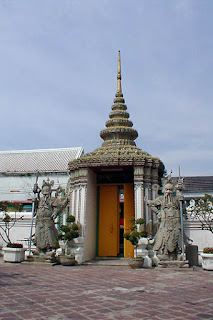











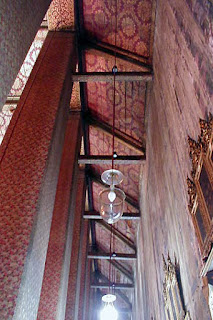
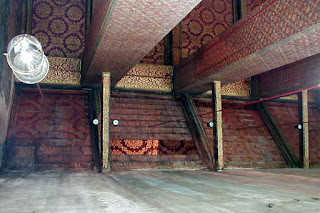






























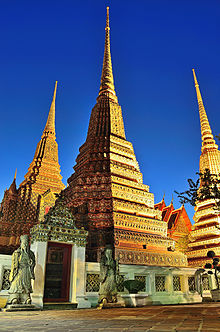




















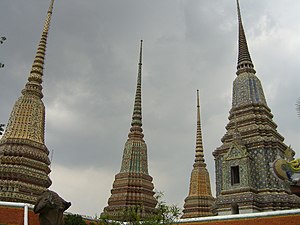






ไม่มีความคิดเห็น:
แสดงความคิดเห็น